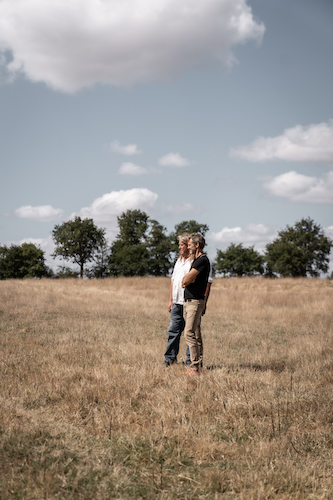Rare breed pigs…..don’t you just love ’em !!!
-
Just to be clear on one thing before going any further – I am not an expert on rare breed pork, far from it. However, having tasted rare breed pork from 2 different farmers in the North East, I can certainly say that the pork is magnificent (in terms of flavour, texture and visually also) and that I will always search out rare breed instead of commercial pork wherever possible.
Now that I’m back in the rainy bustle of the big city that is Paris (yep, the weather here really ain’t that different to back home in Newcastle after all !), my visits to Ravensworth Grange farm a stone’s throw away from the Angel of the North (Anthony Gormley’s magnificent public art project in Gateshead) seem along way away. Ravensworth is a pig and sheep (I know that they would correct me by saying that there are cows, cereals and probably loads of other things) farm run by Ann and Hugh Gray – hidden in the countryside and yet only a few miles from Newcastle. It is the home of the marvellous Middle White pigs.
First things first…..why rare breed pork, and indeed, what is rare breed pork ? With regards to the “What”, rare breeds are simply those that were once bred all over the country before the Second World War, with each region having a speciality. These breeds were then slowly but surely replaced by 1 or 2 more “profitable” and “commercial” breeds (such as the Large White) following a campaign by the British Government during the 50’s to make British Pork more competitive on the open market. The different “rare” breeds in the UK are
There are other more commercial breeds in the UK (Land Race, Welsh, Large White, Duroc, Hampshire and Pietrain) of which Large White is the most widespread.
With regards to the “Why?”, well there is one answer as far as a chef is concerned – flavour ! All rare breeds will have their own characteristics, but in general terms, they take longer to reach maturity, they need more space (unlike the Large White which seemingly accepts being kept in confined places, and thus suits “intensive” commercial farming), the relationship between what they eat and the amount of meat produced is not simple to calculate (thus making it “less efficient” for mass production) and they tend to have much more fat (seemingly from the 1950’s onwards the buying public wanted pork with less fat with the result that low fat breeds became more popular and are now widespread in our supermarkets). This last point is of particular importance to a chef since a good amount of fat ensures that the pork will remain juicy and succulent when cooking, that it will “baste” itself and that the flavour will be much deeper (don’t forget that fat “traps” flavour and is thus an essential part of traditional, flavoursome cooking….leave your butter open in the fridge and you’ll soon see that it will absorb any flavours floating around the fridge). So, basically it’s a “no-brainer”……rare breed is infinately better (in my opinion !!) than the commercial supermarket stuff.
As for Anne and Hugh Gray, I had heard about them through Terry Laybourne’s magnificent book (“A Quest for Taste”) on the real food heroes of the North East – the farmers and the producers. At one time they supplied Terry’s restaurants in Newcastle with their beautiful Middle White pork.
So, off I went for a sunny afternoon outing with Antonella, the kids and even my Dad (who was a bt grumpy that day ’cause he obviously is not used to not driving). Even though the farm is actually not far from Newcastle, it took us about 1 hour to find the place (after several trips out to different farms I now know that the city habit of signposting everything simply doesn’t happen in the “country”)…..I think that this is also why my Dad was a bit grumpy ! Anyway, fortunately it was worth the effort.
Upon arrival, Anne and Hugh were just coming back from herding up their sheep (they also have 500+ sheep in addition to their Middle Whites). We were welcomed with a big smile and though I knew that they had a lot to do during the day (Anne told me on the phone that she’d only be able to spend a short time with us) she took us all around the farm, told us their story, explained about raising the Middle Whites, asked her kids to show Jade and Noé around, talked about her trips to the various Farmers Markets…..in short, we were very well looked after and even my Dad managed to spend a good 30 mins drinking tea with Hugh in the farm kitchen (atleast he wasn’t grumpy anymore) !!
During the summer I was able to buy pork from Anne 3 times – a rolled shoulder (magnificent slow roast at 90°C for 20 hours), a boned top of hind leg (simply roasted for a couple of hours at 160°C….I did nothing, except baste it occasionally) and a beautifully fatty “slab” of pork belly (sealed in a vaccum bag with spices and star aniseed and cooked overnight at 140°C and then cut into square portions for finishing off and reheating “à la commande”). Every time the pork was just gorgeous.
So now that I am back in Paris, the search for the French equivalent is on. At the moment I get the impression that rare breed (“les races anciennes”) is less widespread than in the UK. Once I know more I’ll get back to you all.
I’ll sign off, and if you’ve got any sense you’ll get yourself off to your local Farmer’s market and buy some beautiful rare breed pork !!!!
ps…some sites on rare breeds just to get you (and me!) started






